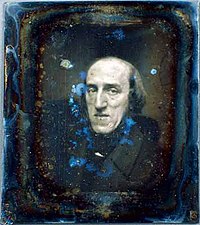Joseph Plateau
| Joseph Antoine Ferdinand Plateau | |
|---|---|

Daguerrotype portrait of Belgian physicist Joseph Plateau dated 1843
|
|
| Born |
14 October 1801 Brussels |
| Died | 15 September 1883 (aged 81) Ghent |
| Nationality | Belgian |
| Institutions | Ghent University |
| Alma mater | University of Liège |
| Doctoral advisor | Adolphe Quetelet |
| Known for | Physics of soap bubbles (Plateau's laws), Plateau's problem |
Joseph Antoine Ferdinand Plateau (14 October 1801 – 15 September 1883) was a Belgian physicist. He was one of the first persons to demonstrate the illusion of a moving image. To do this he used counter rotating disks with repeating drawn images in small increments of motion on one and regularly spaced slits in the other. He called this device of 1832 the phenakistoscope.
His father, born in Tournai, was a talented flower painter. According to Van der Mensbrugghe (1885, p. 390), at the age of six the young Joseph Plateau was already able to read, and this made him a child prodigy in those times. While attending the primary schools, he was particularly impressed by a lesson of physics: enchanted by the seen experiments, he promised himself to penetrate their secrets sooner or later. He used to spend his school holidays in Marche-Les-Dames, with his uncle and his family: his cousin and playfellow was Auguste Payen, who later became an architect and the principal designer of the Belgian railways. At the age of fourteen he lost his father and mother: the trauma caused by this loss made him fall ill.
On 27 August 1840 he married Augustine–Thérèse–Aimée–Fanny Clavareau: they had a son a year later, in 1841. His daughter Alice Plateau married Gustaaf Van der Mensbrugghe in 1871, who became his collaborator and later his first biographer.
Fascinated by the persistence of luminous impressions on the retina, he performed an experiment in which he gazed directly into the sun for 25 seconds. He lost his eyesight later in his life, and attributed the loss to this experiment. However, this may not be the case, and he may have instead suffered from chronic uveitis.
In 1872 he became foreign member of the Royal Netherlands Academy of Arts and Sciences.
He died in Ghent.
Born in Brussels, he studied at the University of Liège (Liège), where he graduated as a doctor of physical and mathematical sciences in 1829.
...
Wikipedia
